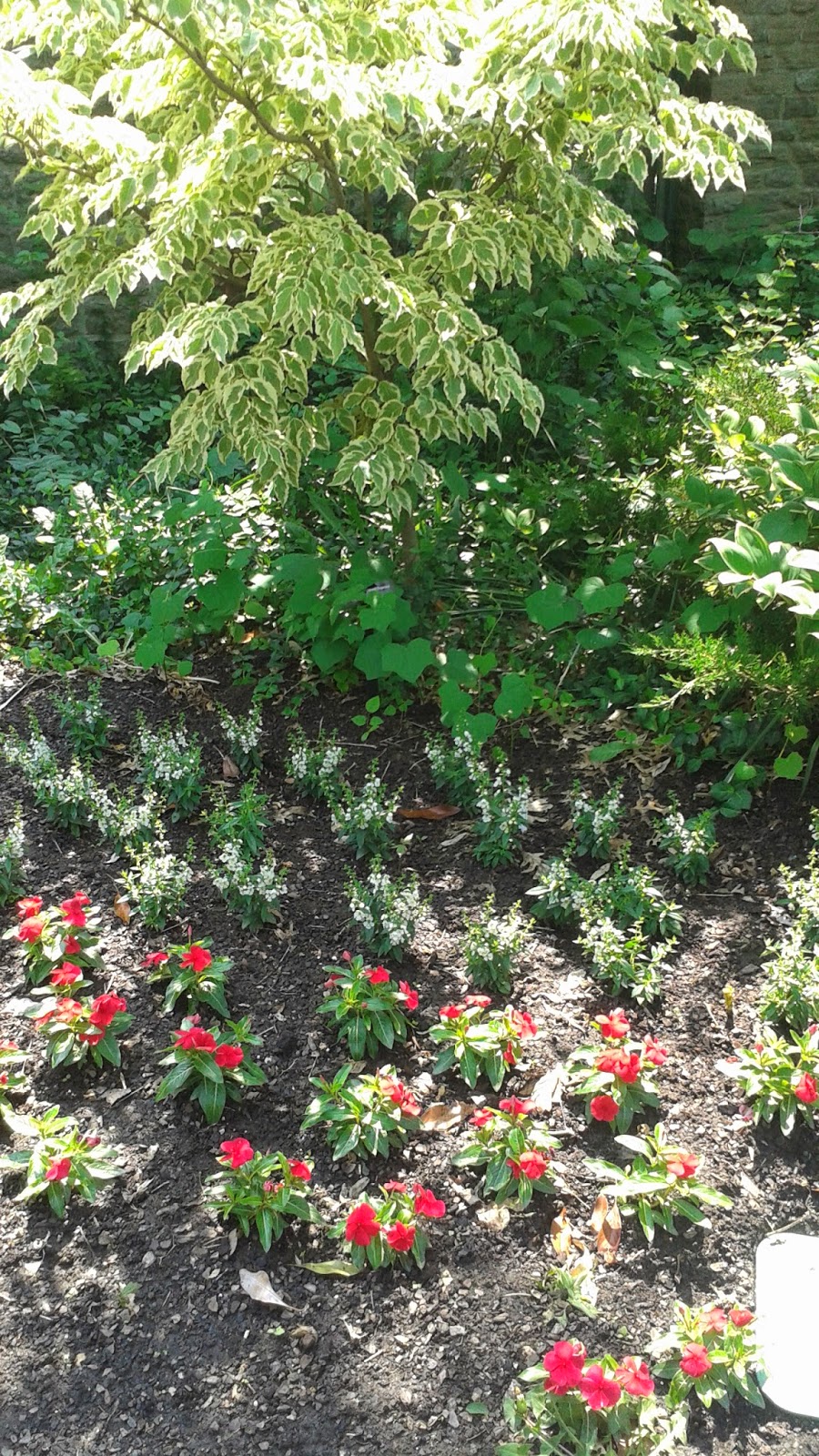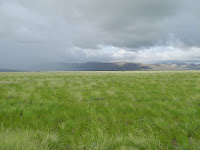Just a few more pics around the traps that I could not resist adding:
Gardens of Prestonia
Sunday 6 July 2014
Annuals
The climate of Cincinnati in the Ohio Valley is variable between the humid continental and the humid subtropical where rainfall is fairly consistent and the deep freeze of the north does not have such a death grip. However the good growing conditions are less than 6 months so annuals have a lot of growing to do (Annual here does not mean annual in Melbourne or anywhere else, but are treated as such).
At The Zoo & Botanical Garden the annuals are donnated by growers, breeders and distributors and planted out in blocks to display and test their worth for the public. They arrive as small seedlings in spring are grown on, planted, maintained, and removed making way for the bulb plantings in autumn/fall.
In only a a few weeks between Mid May and June, warm weather (30C/87F) and many a thunderstorm the annuals are well and truly out of the blocks (along with the weeds - aghhh vines!)
At The Zoo & Botanical Garden the annuals are donnated by growers, breeders and distributors and planted out in blocks to display and test their worth for the public. They arrive as small seedlings in spring are grown on, planted, maintained, and removed making way for the bulb plantings in autumn/fall.
 |
| Impatiens, Angelonia and varieagated Flowing Dogwood |
 |
| 'Sunpatiens', Coleus, Canna |
 |
| Plectranthus Silver Shield, Double Zinnias |
 |
| Geranium and Alocasia |
 |
| Verbena, Begonia Bronze Wing and Pennistemon |
In only a a few weeks between Mid May and June, warm weather (30C/87F) and many a thunderstorm the annuals are well and truly out of the blocks (along with the weeds - aghhh vines!)
 |
| Vinca in foreground, Millet 'Cats Tails' and Impatiens in background |
 |
| Pennistemon |
 |
| One of my faves |
 |
| Canna 'blueberry sparkler' Vinca in foreground |
Containers in Chicago
Urbs in Horto or City in a Garden was proclaimed upon Chicago's founding in 1837
 |
| Near Millenium Park |
 |
| Huge Angelonias (Lantana and Pennisetum in background) |
 |
| A hotel on Michigan Ave |
 |
| Begonias outside the hostel |
 |
| View from the River/Canal in Gotham City* |
 |
| The public library in Gotham City* |
Sunday 27 May 2012
Native Storksbill
Geraniums (Pelargonium xhortorum) had a big rise in popularity during the recent drought in Melbourne. Their native counterpart has many of the attributes and more of the more commonly planted South African species:
Pelargonium Australe
This widespread native species will self seed into a huge range of soil types and conditions, including gravel driveways, pots, rockeries, pretty much anywhere with well drained soils. It can also tolerate heavier soils and compaction. I think it is a great little plant, particularly for a herb/cottage/native garden styles, flowering throughout spring and summer. It also can develop gorgeous red foliage in autumn and winter as a result of colder weather, tolerating a wide range of temperatures. Another Pelargonium species with this feature is the P. rodneyanum that is less vigorous but has a lovely magenta coloured flower. The roots of both species were eaten by Aboriginies in Victoria. The P. rodneyanum has a smaller leaf that is often a glossy deep green rather than dull like the P. australe.
These P. australe were found their way (self-sown) into my silverbeet container. Long after the silverbeet had gone in summer and the pot out of use receiving no additional water, these little pelargoniums remained. So they were transplanted into the windowsill planter box below, facing south where there is very little direct sunlight. They may not reach their full size (small rounded bush to 50cm) in this situation or I may have to thin them out to encourage bushiness.
Edwardes Lake Park
Edwards Lake Park in Reservoir has some really significant community values:
- Open space for public use
- Capturing and filtering storm water for large urban catchment area
- Providing habitat for waterbirds
It features bike/walking paths, BBQ and picnic facilities, several playgrounds, 2 undercover/shelter areas, athletics track and even a sailing clubhouse. It is located adjacent to a sports oval and an industrial complex, it is the largest park in Preston/Reservoir/Thomastown area. As it is a large park, there is balance between revegetation, large mature trees (deciduous, native and pine species), turf and built structures, which appears to be mainly low maintenance. However there is not a great deal of cohesion between the spaces, which could be helped by garden beds drawing lines between the spaces that could still represent values of the park.
The revegetation and development of a billabong wetland system began in the early 2000's, prior to this there was scattered plantings of Eucalypts and Melaleuca throughout the park. The wetland is ephemeral and is dry most of the summer and in winter acts as an overflow area for the lake. Today most of the lake perimeter has been revegetated with semi-aquatic indigenous species. This is important for water quality, erosion control, bird habitat and trapping debris. Due to weed control works and the selection of aggressive and fast growing species, this area has minimal weeds and can cope with inundation and drying out. Recent plantings of grasses, shrubs and forbes compliment the lake edge vegetation but require more maintenance and replanting.
Thursday 24 May 2012
Blooms in the desert
I will have to remind myself to
do a trip to Central Australia when it is bone dry sometime as it would look quite
different to what I saw, after a 3 + years of solidly above average rainfall – the
green centre. Pretty much on the Tropic of Capricorn, it gets a lot of year
round sunshine, add water and a lush garden oasis results.
 |
| Olive Pink Botanic Gardens in Alice Springs Darling Lilies (Crinum sp.) in foreground |
Another feature that makes the
Centre a plant lovers dream is the McDonnell Ranges, that provide a vast array
of microclimates and niches, making it a biodiversity hotspot. The tallest peak
of the ranges is Mt Ziel, 1531 m above sea level, high enough for the very
occasional snowfall. These ranges are surrounded by desert to the south, west,
north and east, however they span a few hundred kilometres east-west either
side of Alice Springs.
Typically the main wildflower
show is spring, however when the below photo were taken in March when many plants were going through a second or third set of flowering due to the high rainfall of 2010/11. Some common species I saw looking a showy spectacular were the Desert Rose (Gossypium sp.), the feathery Ptilotus sp. and Chinese Lantern Abuliton sp.
 |
| Variation in colour of Swainsonia sp. |
Sunday 29 April 2012
The land-use history of the Coburg Hill development site is surprisingly well documented. The traditional owners of the Merri Ck area, Wurundjeri-Willam (part of the Kulin Nation), have left a legacy of stories and artefacts, although their lands were drastically changed in the first few decades of the settlement of Melbourne. Archeological evidence of daily traditional life remains in numerous locations through the northern suburbs despite massive urban and industrial development in the area for over 150 years.
In 1995, a motion was put forward to nominate the Merri Creek for Heritage values on the National Estate, due to its cultural and archeological values. One document suggests that present day Northcote is where the European authorities (John Batman) and the traditional land owners (Kulin Nation elders) signed a treaty worth 243,000 hectares in exchange for European goods in 1835. Interestingly, this treaty was not upheld and declared invalid by the British Crown as did not recognise any land ownership ('terra nullius') in Australia, allowing colonisation to occur.
Growing up in Coburg, Cassy Twomey (nee McKay), explained her family's history of the area:
It began in 1887, when Cassy's great-grandfather purchased the land around Coburg Hill. John Mckay, a dairy farmer, then passed it down to his son William in the 1920's. It was known as Hillcroft or Newlands Farm. The farming of this land was practised until 1977, when Kodak purchased the site, when the house and most of the buildings were removed. The McKay's then purchased farmland where Craigieburn is now located, however development of this region soon ensured its sale.
REFERENCES:
Faithfull., T (ed.) 2001, People of the Merri Merri,Merri Creek Management Committee, Brunswick
In 1995, a motion was put forward to nominate the Merri Creek for Heritage values on the National Estate, due to its cultural and archeological values. One document suggests that present day Northcote is where the European authorities (John Batman) and the traditional land owners (Kulin Nation elders) signed a treaty worth 243,000 hectares in exchange for European goods in 1835. Interestingly, this treaty was not upheld and declared invalid by the British Crown as did not recognise any land ownership ('terra nullius') in Australia, allowing colonisation to occur.
Growing up in Coburg, Cassy Twomey (nee McKay), explained her family's history of the area:
It began in 1887, when Cassy's great-grandfather purchased the land around Coburg Hill. John Mckay, a dairy farmer, then passed it down to his son William in the 1920's. It was known as Hillcroft or Newlands Farm. The farming of this land was practised until 1977, when Kodak purchased the site, when the house and most of the buildings were removed. The McKay's then purchased farmland where Craigieburn is now located, however development of this region soon ensured its sale.
REFERENCES:
Faithfull., T (ed.) 2001, People of the Merri Merri,Merri Creek Management Committee, Brunswick
 |
| McKay homestead, Hillcroft farm, 1974, just prior to demolition |
 |
| William McKay, Hillcroft Farm, 1898 |
Subscribe to:
Posts (Atom)












